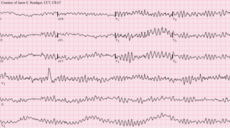Ventricular fibrillation
This article does not have any sources. (July 2014) |
Ventricular fibrillation (often shortened to VF or V-Fib) is a serious type of irregular heart rhythm or cardiac arrhythmia. This is a Cardiac arrhythmia that requires immediate shocks with a Defibrillator and Cardio Pulmonary Resuscitation (CPR). If it’s not treated immediately, a patient can suffer brain damage or death. "Arrhythmia" means the heart is not beating normally.
| Ventricular fibrillation | |
|---|---|
| Classification and external resources | |
 12-lead Electrocardiography (ECG) of ventricular fibrillation | |
| ICD-10 | I49.0 |
| ICD-9 | 427.41 |
| DiseasesDB | 13798 |
| MedlinePlus | 007200 |
| MeSH | D014693 |
What is Ventricular Fibrillation? change
When a person is in ventricular fibrillation, the heart does not beat in any kind of normalized pattern. Instead, it quivers and twitches very quickly.
This problem is called "ventricular" fibrillation because it affects the ventricles of the heart. The ventricles are the biggest parts of the heart. Their job is to pump blood (which carries oxygen) to the lungs or the rest of the body. When a person is in ventricular fibrillation, the ventricles cannot do this job. This means that the lungs, brain, and other organs will not get enough blood or oxygen.
Ventricular fibrillation is a medical emergency. Without enough blood and oxygen, no part of the body can survive. If ventricular fibrillation continues for long enough, the blood will stop circulating around the body. The person's breathing and heart will stop. The person will die unless they get treatment quickly.
Treatment change
Ventricular fibrillation can be stopped by shocking the heart with shocks from a Defibrillator. If a defibrillator is not available,Cardiopulmonary Resuscitation (CPR) should be done to keep the blood flowing until an ambulance comes or a defibrillator is available.
Doctors,Paramedics or other medical personnel can also give special medicines called anti-arrhythmic medicines, which can make the heart start beating normally again. Some common anti-arrhythmic medicines are Amiodarone and Lidocaine. Epinephrine and Atropine or Sodium Bicarb can also be administered if necessary.
If a person with ventricular fibrillation is treated right away, treatment is 90% successful (it works in 9 out of 10 people). But treatment gets 10% less successful after every minute (so if treatment starts after one minute, it will work in only 8 out of 10 people. After 5 minutes, it will work in only 4 out of 10 people.) So getting treatment as soon as possible is very important. If a person cannot be treated with medicine or a defibrillator right away, CPR will help keep blood and oxygen flowing through the person's body until treatment arrives.
In patients who are very likely to keep having ventricular fibrillation, a special defibrillator can be put into their chest by a surgeon. (This special defibrillator is called an "implantable cardioverter-defibrillator.") Any time the person goes into ventricular fibrillation, the defibrillator will give the person's heart an electric shock, to bring the heart back into a normal rhythm.